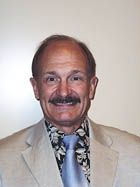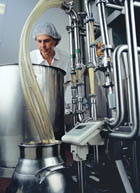
Much of Hotchkiss' research in the last decade has focused on carbon dioxide (CO2) as an antimicrobial agent and packaging tool to extend shelf life. He and his Cornell colleagues have advanced the use of CO2 in a number of dairy applications, including cottage cheese, ice cream and raw milk concentrates and fractions. Their current focus is on CO2 as an aid for transoceanic shipments of raw milk. With a grant from Dairy Management Inc., Hotchkiss and his colleagues are experimenting with shipping containers filled with raw milk and dissolved CO2. Preliminary results suggest product can be delivered to ports an ocean away with lower standard plate counts than it contained at the beginning of the journey. It's an example of what Hotchkiss defines as active packaging: containers that interact with product to improve quality, safety, shelf life and usability.
An expert in toxicology and food and nutrient chemistry, Hotchkiss worked as a supervisory chemist at Adolph Coors Co. before returning to academia in 1974 at Oregon State University, where he received his master's and doctoral degrees. Hotchkiss serves as an advisor to the US Food and Drug Administration and the American Council on Science and Health.
FE: How does CO2 contribute to interstate transportation of milk?
Hotchkiss: The lower the milk's initial bacterial cell counts, the longer its shelf life after processing. The longest you could possibly wait to process raw milk without any intervention would be three days. By adding carbon dioxide, companies are able to get five to six days from the time of milking to processing. Processors remove much of the water prior to transporting milk long distances. Removing water greatly reduces the potential for contamination because bacteria need water. But this also concentrates whatever bacteria are already in the milk.

Hotchkiss: This could be a significant market disrupter by taking away exports from New Zealand. Anytime you heat a product, you denature it, so raw milk would be a nutritionally superior product to dried milk.
One of the key parameters is pressure. Even a small increase in pressure significantly boosts the effectiveness of CO2 as an antimicrobial. Tanker trucks used in interstate shipments of milk weren't built to take any pressure. By pure luck, the shipping containers specified by Agmark Foods Inc. to ship liquid products globally are designed to handle up to 100 psi. We did a trial with one of their 5,300-gallon containers and found it to be well suited. The unrefrigerated containers are very well insulated, and during transport, product temperature rises a maximum of 1




